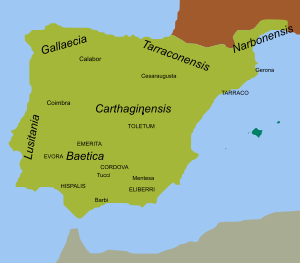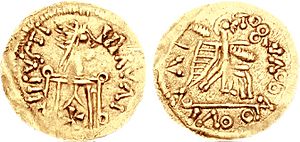Visigothic coinage facts for kids
| Chindasuinth: tremissis | |
|---|---|
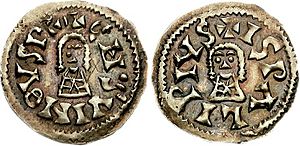 |
|
| +CN•SVINLVS PX, facing bust | +ISPALI PIVS, facing bust. |
| AV Tremissis (1.56 g, 6h). Hispalis (modern-day Seville) mint. MEC 255. | |
The coins of the Visigoths were made in Gaul (modern-day France) and Hispania (modern-day Spain and Portugal). This happened during the early Middle Ages, from the 400s to about 710 AD.
The main coins were the solidus and the tremissis. These were gold coins first made by Roman emperors. The earliest Visigothic coins came from Gaul, where the Visigoths settled in the early 400s. Later, in the early 500s, coins were made in Hispania. Hispania became the center of Visigothic rule after they lost most of Gaul to the Franks.
At first, the Visigoths copied Roman and Byzantine coins. These were called "pseudo-imperial" coins. After 580 AD, they started making coins with the names of their own kings. This "royal coinage" continued until the early 700s. Visigothic rule ended when the Islamic army conquered Iberia.
Contents
Visigothic History and Their Coins
The story of the Visigoths has three main parts:
- They were a traveling group from 376 AD. They settled in southwest Gaul in 418 AD.
- They lived in Gaul until 507 AD. Then, after the battle of Vouillé, Clovis I, King of the Franks, took most of their land in Gaul.
- They moved to the Iberian Peninsula (Spain and Portugal). Their rule there ended with the Islamic conquest in 714 AD.
The Visigoths moved into the Western Roman Empire in the 370s. They adopted many Roman ways. In 418 AD, the Roman emperor Honorius allowed them to settle in Aquitaine. This was the first center of the Visigothic Kingdom. Over time, their kingdom grew to include much of Hispania. By the early 600s, they ruled most of the Iberian Peninsula. This kingdom lasted until the Islamic invasion in 711 AD.
When we look at their coins, we see different periods. The coins from their traveling and Gaul periods look very similar. They mostly copied Roman coins. The coins from their time in Iberia can be split into two phases. First, they kept copying Roman coins. Then, they started making coins with the names of their own Visigothic kings.
Coins from Gaul
| Imitation of Honorius: siliqua | |
|---|---|
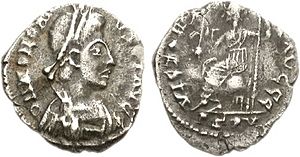 |
|
| D N HONORI-VS [P F] AVG, bust of Honorius facing right, with pearl diadem, mantle, and armour. | VICTOR[I-]A AVGGG, armored Roma seated facing left , holding Victory on a globe with her right hand and a sword in her left hand. |
| AR siliqua, 1,37g, minted in Gaul before 415. Unpublished. | |
South-central Gaul was the heart of the Visigothic Kingdom from 418 to 507 AD. The coins from this time mostly copied Roman designs. They were mainly solidi and tremisses. Some Siliquae were also made. These coins looked very much like the Roman ones. They copied the words and designs, but often not as well. A tremissis was worth one-third of a solidus. A siliqua was one-eighth of a tremissis.
These coins did not have special marks to show they were Visigothic. Experts identify them by their style and where they are found. So, their exact dates are not always known.
The city of Toulouse was likely the main place where these coins were made. It was the Visigothic capital. Some think coins were also made in Narbonne. This is because a lost coin from the 400s had "NB" on it, possibly for Narbonne. Narbonne definitely had a mint later, in the late 500s.
Visigothic coins in Gaul first copied Western Roman coins until about 481 AD. After 509 AD, they started copying Byzantine coins, like those of Anastasius I Dicorus.
Copying Honorius's Coins
The first Visigothic coins were made between 420 and 440 AD. They copied coins made by Honorius (393-423 AD) in Ravenna. The most common type showed Honorius's face on one side. The other side showed the emperor holding a special flag and a globe with a figure of Victory. His foot rested on a captured person.
You can tell Visigothic copies from original Roman coins by their style. The carvings were usually rougher. Small figures often had heads that were too big for their bodies. The letters in the words also looked different.
Copying Valentinian III's Coins
| Imitation of Valentinian III: tremissis | |
|---|---|
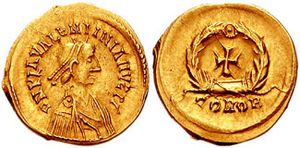 |
|
| D N PLA VALENTINIANVS P G, bust of emperor facing right, with pearl-diadem, armour and drapery. | COMOB, cross within a laurel wreath. |
| AV tremissis, 1,44 g, minted c. 471-507. MEC 171. | |
From about 450 AD, the Visigoths copied coins of Valentinian III (425-455 AD). They made one type of solidus and two types of tremissis. The solidus showed the emperor's face on one side. On the other, the emperor stood on a snake with a human head. He held a cross and a globe with Victory.
One tremissis type showed a cross inside a wreath. The second tremissis type copied a solidus. On this coin, Victory faced forward, holding a cross, with a star nearby.
Copying Libius Severus's Coins
| Imitation of Libius Severus: solidus | |
|---|---|
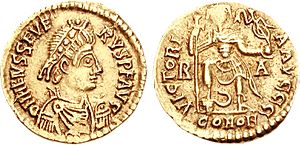 |
|
| D N HBIVS SEVE-RVS P F AVG, bust of emperor facing right. | VICTORIA AUGGG, standing emperor, feet on a human-headed serpent, with a cross and Victory. R-A//COMOB. |
| AV solidus, 4.38 g, c. 461-466. MEC 175 | |
Several solidi were made in the name of Libius Severus (461-465 AD). The most common type was like the solidi of Valentinian III. It showed the emperor standing on a human-headed snake.
Coins from Hispania
In 507 AD, the Battle of Vouillé happened. The Franks, led by King Clovis I, defeated the Visigoths. King Alaric II was killed. The Visigoths lost most of their land in Gaul, including Toulouse. They only kept a small area called Septimania.
The center of the Visigothic kingdom then moved to the Iberian Peninsula. Their kingdom grew strong there until the Islamic invasion in 711 AD.
Pseudo-Imperial Coins (509-580 AD)
| Imitation of Justinian I: tremissis | |
|---|---|
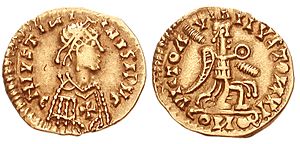 |
|
| C N IVSTIИIINVS IPVC, bust of emperor facing right. | VICTOΛ VIΛ IIVSTOИVI, Victory facing right, holding a palm and a crown; COИOB. |
| AV, tremissis, 15mm, 1,42 g. Mint of Narbonne or Barcelona. c. AD 527-565. Not in MEC. | |
During this time, only solidi and tremisses were made. These coins had the names of Byzantine emperors like Anastasius I, Justin I, and Justinian I. You can tell them apart from real imperial coins by their style. Also, they are only found in the Iberian Peninsula. The most common designs showed a standing Victory holding a cross, or a Victory facing right, holding a palm and raising a crown.
Royal Coins (580-710 AD)
From the 580s, Visigothic kings started making coins with their own names. This was the last period of Visigothic coinage. It lasted about 130 years. No coins are known after 710 AD, because the Visigothic kingdom was taken over by the Umayyad invasion.
Only tremisses were made during this time. The gold used became less pure over the years. The coins showed the king's name and the name of the city where they were made. Unlike other coins of the time, they did not show the name of the person who made them.
From Liuvigild to Chindasuinth
The first royal coins were made during the rule of Liuvigild (567-586 AD). For a short time, coins copied Byzantine designs but had the Visigothic king's name. One example is a tremissis of Liuvigild made in Barcelona. It showed the king's face on one side and a cross on steps on the other. The words identified the king and the city. Another type showed the king facing right and Victory with a palm and crown.
Some coins of Liuvigild showed a king's face on both sides. This new design became common for Visigothic coins. It started in the last years of Liuvigild's rule. Some historians think this change happened to show that Liuvigild's son, Reccared I, was now co-ruler. Coins with this style were made for over sixty years, until the end of Chindasuinth's rule (641-652 AD).
The faces on the coins changed depending on the mint and the king. Kings were shown without crowns, even though Isidore of Seville said Liuvigild introduced crowns. Instead, at least one face had long hair, which was a sign of royal power for ancient Germanic peoples.
From Recceswinth to Wittiza
Around 649 AD, a new coin design appeared. It had the name of Recceswinth, who was now ruling with his father Chindasuinth. This coin had a symbol for the mint's name instead of a face on one side. The other side showed a king's face in profile (from the side). After Chindasuinth died, mints made different choices. Some went back to the two-face design. Others, like Seville, kept the new design with a symbol and a profile face.
| Tremissis of Erwig (680-687) | |
|---|---|
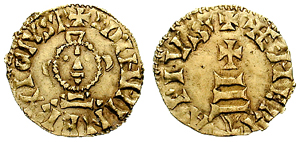 |
|
| +ID IN M N ERVIGIVS RX, facing bust of Christ with a cross behind his head | +EMERITΛ PIVS, cross over three steps. |
| (1,43 g). mint of Emerita (Mérida). Miles 415a; MEC 267 | |
For the rest of Recceswinth's rule, all mints made coins with a profile face and a cross on steps. The king's face sometimes had a helmet or was bare-headed. Kings were usually shown with beards, unlike earlier coins that copied Byzantine styles. Later kings used the same design. Only during the joint rule of Egica and Wittiza was a new type introduced. It showed two faces separated by a scepter with a cross.
Another special coin was the tremissis made under Erwig. It showed a face of Christ instead of the king. The other side had a cross on steps. These coins were first made in Mérida, Spain. Over time, the quality of the carving got worse. On some coins, the cross behind Christ's head looked like ears. Historians think these coins show important religious ideas of the time.
No official coins are known after the rule of Wittiza, which ended in 710 AD. However, fake coins of Roderic have been found.
Coin Words and Letters
The words on the coins were usually in Latin. They gave the king's name, followed by "REX" (meaning king). Sometimes "REX" was shortened into a symbol like the one shown.
During the joint rule of Egica and Wittiza, the coins said "reges" (meaning kings). Under Liuvigild and Ermenegild, the king's name was often preceded by "D N," short for "dominus" (meaning lord). Under Chindasuinth, the mint in Toledo started using "INDN," which meant "In nomine Domini" (in the name of the Lord). This became common until the rule of Wamba.
The names of the kings were spelled in many ways. For example, Suintila could be written as SVINTHVLΛ, SINTILΛ, or SVINTH:L:. The more complex the name, the more variations there were. Letters were sometimes combined.
The other side of the coin had the name of the mint (the city where it was made) in Latin. TOLETO, CORDODΛ, ISPΛLI, and ELVORΛ meant Toledo, Cordoba, Seville, and Évora. Sometimes the mint was shown only by a symbol.
The letters on Visigothic coins are unique. The letter "A" was often written without a bar (Λ). The letter "D" was often replaced with a Greek letter Delta (Δ). The "th" sound was often written with a Greek letter Theta (Θ). The letter "L" was sometimes just a cross (+). Sometimes dots were used instead of letters, especially vowels.
The mint's name on the coin was usually followed by a royal title. The most common was "PIVS" (pious or devout). "IVSTUS" (just) was also common. "FELIX" (lucky) and "VICTOR" (victorious) were also used.
Where Coins Were Made
Experts have found over 80 places where Visigothic coins were made. Most of these mints were small. We only know about them from a few coins, sometimes just one or two.
About half of the 3500 existing coins came from four main mints. These were the capital city of Toleto (Toledo) and three southern cities: Emerita (Mérida), Ispalis (Seville), and Cordoba. Other important mints, with about one to two hundred coins each, were Eliberis (near Granada) and three northern mints: Cesaracosta (Zaragoza), Tarraco (Tarragona), and Narbona (Narbonne). Narbona was the last mint the Visigoths controlled north of the Pyrenees mountains after the Battle of Vouillé.
Some smaller mints were in Gallaecia (modern-day Galicia). This area had important mines since Roman times. We don't have many records about how these mints were organized. We mostly learn about them from how the coins changed over time.
Coin Hoards
Several large collections of Visigothic coins have been found. The most important recent discovery was the Zorita de los Canes hoard, found by archaeologists in 1945.
A collection of coins from Reccared I and other kings was found in Garrovillas de Alconétar in 1731. We don't know exactly what was in it, but a large part is now at the Real Academia de la Historia. In 1803, a hoard in Bordeaux included 38 Visigothic tremisses. In 1816, over 800 coins were found in La Grassa, near Constantí, but they were scattered soon after.
The La Capilla hoard, found in 1891, likely had between 800 and 1000 coins. Even though they were spread out, over a third of the remaining coins are now in the Hispanic Society of America collection. In 1932, 110 Visigothic coins were found in Abusejo. They are now in the National Archaeological Museum of Spain and the Instituto Valencia of Don Juan.
The Zorita de los Canes hoard was found at the site of the Visigothic city of Reccopolis in 1945. It includes 90 tremisses. The latest coins were from Livuigild I. They did not have mint names, but were probably made there.
See also
 In Spanish: Monedas del reino visigodo para niños
In Spanish: Monedas del reino visigodo para niños



